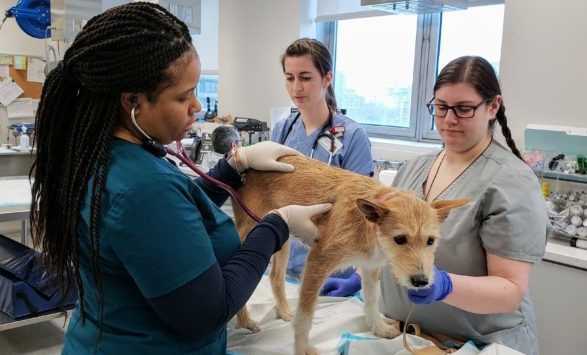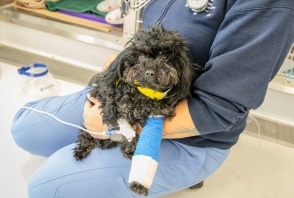Cancer in Pets – An Overview
Background
When cells or tissues in the body begin to grow abnormally and uncontrollably, this is called neoplasia. A tumor, or a swelling of the part of the body, is a created as a result of uncontrolled cell growth. Tumors can be either benign or malignant. A benign tumor is not invasive, meaning the rapidly growing cells are localized to one area and do not invade the rest of the body. However, malignant tumors are made up of cells that spread throughout the body (metastasize) and harm other tissues, most commonly the lung and lymph nodes. The term “cancer” specifically refers to malignant tumors which spread and grow rapidly throughout other areas of the body.
Cancer is not one disease, but hundreds. Cancer can be grouped into three main categories:
- Carcinomas – carcinomas are formed by epithelial cells, which are the cells that cover the inside and outside surfaces of the body. Tumors of the anal gland, mammary gland, and bladder are types of carcinomas in dogs and cats.
- Hematopoetic tumors – blood cancer, or hematopoetic tumors, include mast cell tumors, leukemia and lymphoma. At the Schwarzman Animal Medical Center, lymphoma is a common cancer treated in both dogs and cats. Lymphoma in Dogs Lymphoma in Cats
- Sarcomas – sarcomas are tumors formed by cells from bone and soft tissues, including muscle, fat, blood vessels, lymph vessels, and fibrous tissue (such as tendons and ligaments). Examples of sarcomas in dogs include soft tissue sarcoma, hemangiosarcoma, and osteosarcoma.
Causes of Cancer
The development of cancer has a wide range of causes:
- Genetics – certain dog breeds, such as Bernese Mountain dogs, Boxers, Golden retrievers, and Rottweilers are more likely to develop specific types of cancer than other breeds. This suggests a genetic component to the development of certain cancers.
- Hormones – hormones can play a role in the development of cancer. For example, female dogs and cats that aren’t spayed are at risk for developing mammary tumors (breast cancer).
- Environment – pets can be exposed to carcinogens (substances capable of causing cancer) within their environment. Carcinogens can include ultraviolet radiation from sun exposure, pesticides, secondhand smoke, and pollution.
- Age – cancer appears to occur more frequently in older pets. As a matter of fact, half of dogs over the age of 10 will develop cancer.
- Viruses – certain viruses can cause cancer in pets. For example, feline leukemia virus (FeLV) is a viral infection that attacks a cat’s immune system.
- Trauma – sites of traumatic injuries may develop cancer, such as the location of a bone fracture.
- Injection Site – one type of sarcoma, known as feline injection-site sarcoma (FISS), is an uncommon tumor that grows at the site of an injection such as a vaccination.
Common cancers in dogs include:
- Anal gland tumors
- Breast cancer
- Hemangiosarcoma
- Lymphoma
- Mast cell tumors
- Melanoma
- Osteosarcoma
- Soft tissue sarcoma
Common cancers in cats include:
- Basal cell tumors
- Breast cancer
- Injection site sarcoma
- Lymphoma
- Mast cell tumors
- Osteosarcoma
- Squamous cell carcinoma
Signs of Cancer
Because cancer can affect any area of the body, there are a wide variety of clinical signs that may or may not indicate cancer as the underlying disease. However, you should always be on the lookout for any abnormalities in your pet’s health. Below is a list of warning signs that could indicate cancer in your pet:
- Lumps and bumps
- Abnormal odors
- Abnormal discharge
- Non-healing wounds
- Weight loss
- Changes in appetite
- Coughing or difficulty breathing
- Lethargy & depression
- Changes in bathroom habits
- Evidence of pain
The above list is not exhaustive. Should you ever notice any unusual changes in your pet, be sure to take them to the veterinarian right away.
Diagnosing Cancer
How cancer is diagnosed can depend on the type of cancer being investigated. However, suspected cancer cells need to be tested through microscopic examination to determine if they are actually malignant. Your veterinarian will need to perform a biopsy and remove a piece of body tissue that can be analyzed in a laboratory. This can be a simple procedure such as a fine needle aspirate, in which a small needle is inserted into the tumor in order to pull out some cells, or it can require surgery to remove the piece of tissue.
Imaging technologies, such as x-rays, ultrasound, MRI, and CT scans can be used to confirm the location of a tumor and design appropriate treatment options for your pet.
Treatment of Cancer
There are a variety of options available for treating cancer, but the methods used will depend on the type of cancer your pet has, the stage of cancer they are experiencing, and what options work best for you and your family:
- Chemotherapy – chemotherapy is most often used when a biopsy indicates a tumor has spread or might spread throughout the body. Chemotherapy drugs can be delivered orally or by injection.
- Surgery – the surgical removal of a tumor can be a treatment option for certain cancers, such as breast cancer, soft tissue sarcomas, and mast cell tumors. The key to treating many types of tumors with surgery is to remove a wide swath of normal skin and tissue around the tumor to ensure complete removal of the cancer-causing cells.
- Radiation therapy – the goal of radiation therapy is to eradicate tumors by targeting high-energy beams at precise points on the body. It is important that these beams target cancerous cells and hit as few healthy cells as possible, so pets need to be anesthetized and precisely positioned in the machine in order for the laser to deliver radiation therapy most effectively.
- Immunotherapy – immunotherapy uses a patient’s own immune system to fight the cancer cells. Types of immunotherapies include administering vaccines and monoclonal antibodies.
- Targeted therapy – targeted therapy works by exploiting the abnormalities in cancer cells that cause them to grow and spread. Certain drugs can then be used to target these specific proteins on the cancer cells to stop them from growing and metastasizing.
- Combination therapy – combination therapy refers to the use of two or more treatment options when treating a pet with cancer.
Unfortunately, not all cancers can be cured. In these cases, treatment can focus on lengthening a pet’s lifespan or increasing their quality of life while living with cancer. Palliative care is an option for terminally sick animals with the goal of controlling pain and modifying the pet’s environment to make day-to-day living more manageable.
Reducing Cancer Risk
Most cancers cannot be prevented, but there are things pet owners can do to reduce the risk of their pet developing certain types of cancer. Spaying and neutering pets early in their life, for example, can help reduce the risk of pets developing breast cancer and eliminates the risk of ovarian and testicular cancer. Vaccinating your outdoor cat against FeLV will help to prevent infection with this virus which increases a cat’s risk of lymphoma 50 times that of an uninfected cat. By minimizing injections and using the American Animal Hospital Association’s feline vaccination guidelines to direct your cat’s vaccination plan, you will help to mitigate the risk of an injection site sarcoma. Because smoke settles onto the floor and you pet is much closer to the floor than you are, they have a greater risk of secondhand smoke exposure. Stop smoking to protect your pet and yourself.
Caring for a Pet with Cancer
If your pet is undergoing cancer treatment, providing supportive care at home is critical. Your pet will likely be prescribed medication to help relieve pain or reduce nausea. Your veterinary oncologist may also recommend a change in diet or the use of appetite stimulants to make sure your pet is getting adequate nutrition. Depending on the type and stage of cancer in your pet, you may need to help your pet with daily activities, such as feeding or bathroom breaks if your pet struggles to do these tasks on their own.
Whether your goal for your pet’s cancer treatment is cure, remission, or simply maintaining a good quality of life, unfortunately, cancer can sometimes become a life-limiting condition. For palliative care at home, modifications can be made to your pet’s environment to keep them as comfortable as possible in their final days or months. This can include adding non-skid floor surfaces to make walking easier, raising food dishes and water bowls, adding ramps to litterboxes or beds, and creating rest areas for your pet to comfortably hang out.
Euthanasia, while an enormously difficult decision, is an option for pets diagnosed and suffering with cancer. If you are struggling with the decision whether to euthanize or not, you can always discuss the choice with your veterinarian who can provide a medical assessment of your pet’s condition and quality of life. The goals of euthanasia are to relieve pain and suffering, reduce distress the pet may feel towards the end of their life, and provide a painless and peaceful death.
Caregiving for a pet with cancer can be very rewarding and it can also be emotionally and physically demanding. It is normal for feelings of grief, worry, loneliness, exhaustion, and frustration to intermingle with feelings of love and gratitude as you care for your pet. It is important to seek out support from your pet’s care team and from trusted supports in your life to help you through this difficult time.
Make an Appointment

Oncology
AMC's Cancer Institute is a revolutionary medical center, created to provide integrative and comprehensive care for pets diagnosed with cancer.
Learn More































